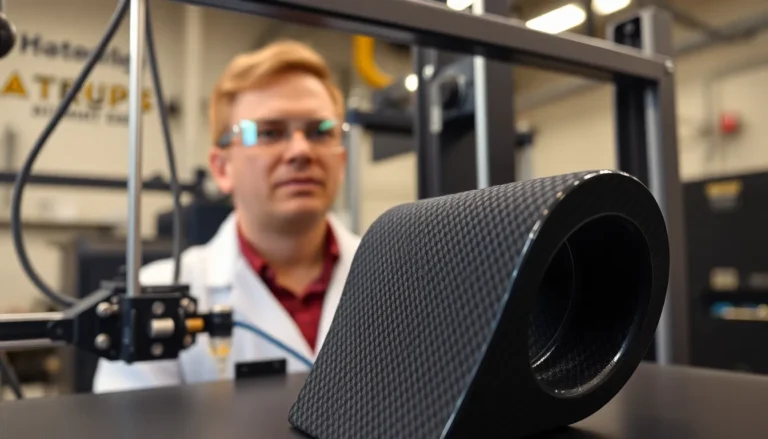Table of Contents
ToggleIn a world where data is the new oil, energy-efficient data centers are the sleek, eco-friendly Teslas of the tech landscape. They’re not just saving the planet; they’re also saving businesses a pretty penny. Imagine a place where servers hum like content cats while consuming less energy than your average household fridge. Sounds like a dream, right? Well, it’s time to wake up and smell the renewable energy!
As companies scramble to keep up with the digital gold rush, they’re discovering that going green isn’t just a trendy Instagram post; it’s a smart business move. Energy-efficient data centers reduce operational costs and carbon footprints, proving that you can be both environmentally responsible and financially savvy. So buckle up as we dive into the world of energy-efficient data centers, where sustainability meets innovation, and every kilowatt saved is a step toward a brighter future.
Overview of Energy-efficient Data Centers
Energy-efficient data centers play a crucial role in modern computing. These facilities utilize advanced technologies to minimize energy consumption while maintaining performance. Design choices, including optimized cooling systems and energy-efficient servers, directly impact operational costs.
Renewable energy sources are increasingly powering data centers. Solar panels and wind turbines contribute to a sustainable energy mix. Implementing energy management systems ensures real-time monitoring of power usage.
Innovative practices, such as virtualization and server consolidation, enhance efficiency. These strategies reduce the number of physical machines while optimizing application performance. Additionally, strategic placement of equipment aids in cooling efficiency.
Sustainability certification programs, like LEED and ENERGY STAR, recognize energy-efficient operations. Companies pursuing these certifications demonstrate their commitment to reducing carbon footprints. Regulatory incentives might also encourage businesses to adopt greener technologies.
Energy-efficient data centers not only address environmental concerns but also yield significant cost savings. Companies report lower electricity bills and improved overall performance metrics. As the demand for data storage and processing continues to rise, the push for energy efficiency remains paramount.
The evolution of energy-efficient data centers reflects a commitment to sustainability. Adoption of these practices not only benefits the environment but also enhances business operations. Embracing energy efficiency becomes an integral aspect of modern data management and organizational strategy.
Benefits of Energy-efficient Data Centers

Energy-efficient data centers provide significant advantages, impacting both operational outcomes and environmental health.
Cost Savings
Cost savings represent a major benefit. Companies experience lower electricity bills due to reduced energy consumption. Efficient cooling systems, advanced server technologies, and optimized energy management contribute to this reduction. Lower operational costs enable investments in other business areas, fostering growth. Energy-efficient practices often qualify companies for tax rebates and incentives, further enhancing savings. As the demand for data processing increases, anticipated savings translate into substantial financial benefits over time.
Environmental Impact
The environmental impact of energy-efficient data centers is profound. These facilities significantly lower carbon footprints by utilizing renewable energy sources, such as solar and wind. Advanced cooling techniques reduce waste and enhance energy utilization. Many businesses adopt sustainability certification programs, reflecting their commitment to eco-friendly practices. Reducing reliance on non-renewable resources fosters a healthier planet. As companies embrace these solutions, they contribute to global sustainability goals, showcasing responsible stewardship of resources.
Technologies Driving Energy Efficiency
Energy-efficient data centers leverage innovative technologies to enhance energy performance. These advancements include virtualization and optimized coolant systems that significantly reduce energy consumption.
Virtualization
Virtualization is essential in modern data center efficiency. This technology allows multiple virtual servers to run on a single physical machine, effectively reducing hardware requirements. By cutting down the number of physical servers, organizations lower energy use and associated costs. Companies frequently notice improved server utilization rates due to virtualization, which enhances resource management. Additionally, this approach simplifies maintenance and streamlines operations, contributing to overall efficiency. Many businesses find virtualization aligns with sustainability goals, providing a cleaner, greener IT infrastructure.
Coolant Systems
Advanced coolant systems play a critical role in energy-efficient data centers. These systems optimize cooling to maintain ideal temperatures for server performance while minimizing energy usage. Techniques such as liquid cooling and free cooling offer significant advantages. Liquid cooling directly targets heat generated by servers, proving more efficient than traditional air cooling methods. Utilizing external air for cooling also lowers energy consumption, especially in cooler climates. As data centers increasingly adopt these technologies, they observe substantial reductions in cooling-related energy expenses. The integration of smart sensors further enhances management, enabling real-time monitoring and adjustments for maximum efficiency.
Design Strategies for Energy Efficiency
Design strategies play a crucial role in achieving energy efficiency in data centers. Implementing innovative solutions can significantly reduce power consumption and operational costs.
Modular Design
Modular design offers flexibility and scalability for data centers. Prefabricated components allow for easy upgrades and expansions without extensive renovations. This approach reduces waste and optimizes resource use during construction and ongoing operations. Furthermore, each module can be tailored for specific energy needs, ensuring efficient power distribution. Organizations benefit from reduced downtime during upgrades, enhancing overall efficiency.
Renewable Energy Integration
Integrating renewable energy sources into data center operations enhances both sustainability and cost savings. Solar panels and wind turbines provide clean energy alternatives to traditional sources. Utilizing energy storage systems, like batteries, allows for better energy management and maximizes the use of generated renewable energy. Data centers maximize their energy independence while lowering operational costs. Additionally, collaboration with local energy providers can result in favorable agreements and support for renewable projects.
Future Trends in Energy-efficient Data Centers
Emerging advancements shape the future of energy-efficient data centers significantly. AI-driven management systems enhance operational efficiency and optimize energy consumption for improved performance. Researchers highlight the potential of machine learning algorithms for predicting energy usage patterns, paving the way for proactive adjustments.
In addition, edge computing is gaining momentum as it reduces latency and optimizes resource utilization. Placing data processing closer to end-users minimizes energy loss during transmission, ultimately lowering overall energy demands. Several companies are adopting this trend for expanded efficiency.
Another important trend involves the widespread integration of renewable energy sources. Energy procurement models shift as organizations increasingly invest in solar and wind projects to power their operations sustainably. This transition not only reduces reliance on fossil fuels but also aligns with corporate sustainability goals.
Innovative cooling solutions play a crucial role in future data center designs. Liquid cooling systems, for instance, outperform traditional methods by managing heat effectively while consuming less energy. Enhanced cooling techniques complement the push for sustainability by maintaining optimal operating temperatures.
Retrofit programs also emerge as essential strategies for existing data centers. Updating facilities with energy-efficient technologies reduces both operational costs and carbon footprints. Organizations that commit to retrofitting their infrastructure often see significant long-term savings.
Moreover, collaboration between technology providers and infrastructure developers strengthens the energy efficiency movement. Partnerships foster innovation, leading to the development of advanced technologies that further lower energy consumption. As collaboration intensifies, the collective impact on sustainability becomes even more profound.
Energy-efficient data centers are transforming the tech landscape by marrying sustainability with operational efficiency. As businesses increasingly adopt these practices they not only reduce their carbon footprints but also enjoy significant cost savings. By leveraging advanced technologies and innovative design strategies organizations can optimize energy consumption while maintaining high performance.
The future of data centers lies in the integration of renewable energy sources and smart management systems that enhance efficiency. As the demand for data processing continues to grow the commitment to energy efficiency will become even more critical. This shift not only supports environmental goals but also positions companies as leaders in a rapidly evolving industry.




